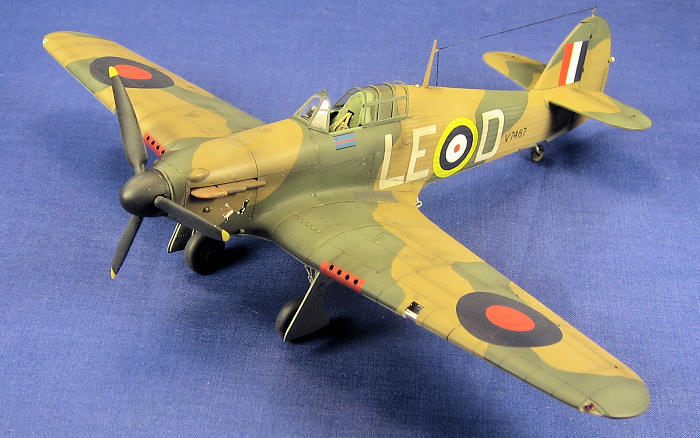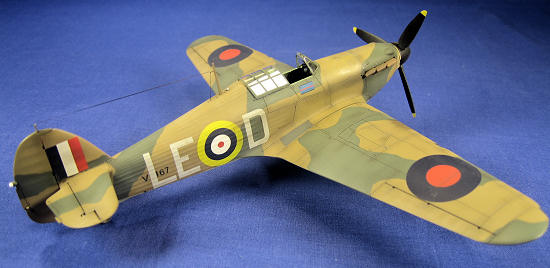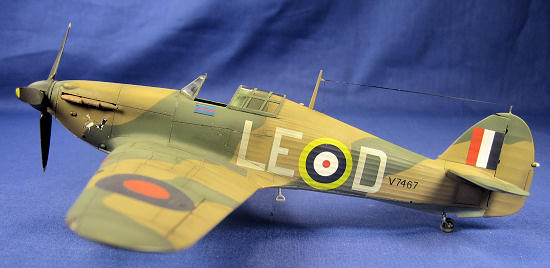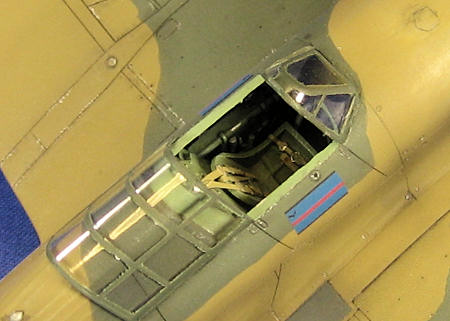
| KIT #: | 9065 |
| PRICE: | $30.00 or so |
| DECALS: | Two options |
| REVIEWER: | Scott Lyle |
| NOTES: | Superscale 48-383 decals and Ultracast 48043 Exhaust used. |

| HISTORY |
Though never as
glamorous as the Spitfire, the Hurricane in fact shot down more enemy aircraft
during the Battle of Britain than any other British aircraft.
One of the truly important fighters of the early part of the war, the
Hurricane saw action in every theater and by the end of 1944 over 14,000 had
been built, including some 1,400 that were built in
 First deployed
during the Battle of France, the Hurricane quickly endeared itself to its pilots
and crews thanks to its relatively simple design and ease of maintenance.
At the start of the Battle of Britain there were twenty-six squadrons
of Hurricanes at the RAF’s disposal.
The Hurricanes were generally in charge of going after the bombers,
with the Spitfires in charge of attacking the Luftwaffe’s fighters.
By the end of that campaign the Hurricane had shot down 57% of all the
German aircraft lost in combat, and 272 Bf 109s were downed for the loss of 153
Hurricanes.
First deployed
during the Battle of France, the Hurricane quickly endeared itself to its pilots
and crews thanks to its relatively simple design and ease of maintenance.
At the start of the Battle of Britain there were twenty-six squadrons
of Hurricanes at the RAF’s disposal.
The Hurricanes were generally in charge of going after the bombers,
with the Spitfires in charge of attacking the Luftwaffe’s fighters.
By the end of that campaign the Hurricane had shot down 57% of all the
German aircraft lost in combat, and 272 Bf 109s were downed for the loss of 153
Hurricanes.
By the end of 1941 the design was starting to show its age and they
increasingly began to be used in the night fighter role.
Hurricanes saw plenty of action in
One of the most famous Hurricane pilots of the Battle of Britain was Douglas Bader, a legend of a man who became an ace pilot even though he had lost both legs in an air crash in 1931. When the war ended he had 22 kills to his credit, despite the fact that he spent the last three and half years of the war in German captivity.
| THE KIT |
Hasegawa’s 1/48 Hawker Hurricane Mk. I has been around for a while and is a well chronicled model. Molded in light gray plastic, it features finely recessed lines, a very high level of detail, and a simple and logical breakdown of parts – in short, it has all of the quality we have come to expect from Hasegawa.
| CONSTRUCTION |
 The
interior nicely recreates the tubular structure of the real aircraft and was
painted using Testors RAF Interior Green, and then washed with a raw umber oil
wash. The
instrument panel decal responded well to Walthers Solvaset.
Once that was dry, I picked out the various details by hand, using the
Squadron/Signal Walk Around book as a reference.
A set of seatbelts from the spares box were added to the seat and the
cockpit was finished.
The
interior nicely recreates the tubular structure of the real aircraft and was
painted using Testors RAF Interior Green, and then washed with a raw umber oil
wash. The
instrument panel decal responded well to Walthers Solvaset.
Once that was dry, I picked out the various details by hand, using the
Squadron/Signal Walk Around book as a reference.
A set of seatbelts from the spares box were added to the seat and the
cockpit was finished.
The rest of the airframe went together fairly well. There was a step that had to be filled and sanded where the bottom rear of the wings met the lower fuselage, which was a bit fidgety. I left off the landing gear and their doors, as well as the usual antennas, foot steps, etc, as we all know those wouldn’t stand a good chance of surviving the painting process! I attached the gun sight and windscreen, but left off the sliding canopy. Once both parts of the “greenhouse” were masked, I airbrushed them with the RAF Interior Green to replicate the interior color of the frames. Once that was dry, the model was ready to be painted.
| COLORS & MARKINGS |
I sprayed a
primer coat of Mr. Surfacer 1000 onto the aircraft and then checked for any
seams that needed to be touched up.
I then pre-shaded the panel lines on the underside with some Testors
Acrylic Gunship Gray.
Next the underside was airbrushed with Testors Acrylic Sky, and then
masked in preparation for spraying the upper surfaces.
I airbrushed Testors Acrylic Dark Earth first onto all of the upper
surfaces, and then once that was dry, started masking it using Silly Putty.
I got the idea for using Silly Putty from the Tamiya Model Magazine,
and it’s great for masking camouflage patterns.
It sticks easily to the model, but
 doesn’t
pull up any paint when you remove it, at least not in my experience.
Because it’s so flexible, you can easily mold it into the shapes you
want, which makes it much quicker to work with then tape or paper masks.
Once it’s on the model you can squish it around if you don’t like how
something looks, and when the paint is dry, you peel it off and put it back in
its egg to reuse again later!
Nothing could be easier; perhaps the only consideration is that you
will get a hard-edged camouflage scheme with the stuff.
But then better modelers than I have probably figured a way to use it
in such a way as to get a soft edge.
doesn’t
pull up any paint when you remove it, at least not in my experience.
Because it’s so flexible, you can easily mold it into the shapes you
want, which makes it much quicker to work with then tape or paper masks.
Once it’s on the model you can squish it around if you don’t like how
something looks, and when the paint is dry, you peel it off and put it back in
its egg to reuse again later!
Nothing could be easier; perhaps the only consideration is that you
will get a hard-edged camouflage scheme with the stuff.
But then better modelers than I have probably figured a way to use it
in such a way as to get a soft edge.
With the Hurricane decked out in a Silly Putty ‘A’ scheme mask, I
airbrushed Testors Acrylic Dark Green onto the model.
I removed the Silly Putty, and then coated the model with Future in
preparation for the decals.
The Superscale decals worked fine with Walthers Solvaset, and once
they were set I airbrushed a coat of Future over the whole model again to seal
them. After that
had cured I applied a wash of 50/50 Lamp Black/Raw Umber oil paint to all of the
recessed panel lines.
I then airbrushed a coat of Testors Lacquer Flat
 Finish
over the whole model, and then airbrushed a very thin 50/50 mix of Tamiya
Black/Red Brown over the panel lines, exhaust areas, and behind the machine
guns.
Finish
over the whole model, and then airbrushed a very thin 50/50 mix of Tamiya
Black/Red Brown over the panel lines, exhaust areas, and behind the machine
guns.
The exhausts were drybrushed in different shades of Testors Rust and
Steel, and the wheel wells, landing gear, and gear door interiors were painted
Testors Aluminum.
A wash of Black/Raw Umber oils added some grime to the area.
The prop hub and blades were hand-painted Tamiya XF-69 NATO Black,
with the yellow tips added in Testors Yellow.
Next I added some paint chips around the nose, cockpit, and wing roots
using a Silver Berol pencil, keeping it subtle.
My final weathering step was to airbrush a bit of Tamiya Desert Yellow
on the tires and tail wheel to simulate some dust and dirt.
Finally I painted the wingtip lights, attached the prop and canopy, and then completed the model by adding an EZ-Line antenna wire.
| CONCLUSIONS |
Hasegawa’s 1/48
Hurricane is yet another fast and pleasant build.
An important fighter that was flown by many fascinating pilots, I’m
glad to have a nice replica of the Hurricane in my collection.
| REFERENCES |
-
Osprey Publications, Aircraft of the Aces #18, “Hurricane
Aces 1939-40”
-
Squadron/Signal Publications, Aircraft in Action #72,
“Hurricane in Action”
-
Squadron/Signal Publications, Walk Around #14, “Hurricane”
August 2009
If you would like your product reviewed fairly and quickly, please contact me or see other details in the Note to Contributors.